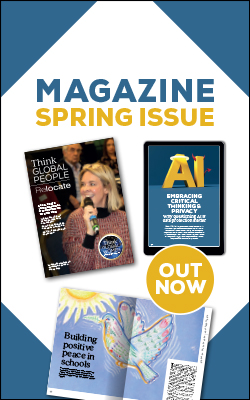Higher Education: Addressing Challenges in the Years Ahead
The Higher Education sector is facing a number of challenges but is responding to these proactively, with determination and resolve.

Click on the cover to access the digital edition or read all of the articles on our website.
Gaining a university place
University staff are primarily working remotely in team communities with professional service and academic staff members responding to calls and emails from prospective students seeking a university place. Prospective students and their concerned family members can rest assured that all universities taking part in clearing are seeking to fill places on all their courses which have space. Emphasis is being placed on a responsible approach to prospective new student communication to help ensure the choices they make are best for their own position. In these exceptional times, many HE institutions are also opening the doors a little more widely, taking a compassionate approach to grades awarded.Despite the unprecedented array of uncertainties about how things will progress over the coming weeks given the extraordinary events currently taking place, HE institutions have robust plans in place for tuition delivery. For example, buildings have been made Covid-secure over the summer vacation period with one-way systems, signage, screens, hand-sanitiser stations and adaptation of classroom and social space for socially distanced learning. Large lectures will be delivered online, not in lecture halls.Remote solutions
Many universities are planning for remote teaching for subjects that can be delivered fully online, leaving socially-distanced premises space for the delivery of subjects that will require physical presence for small group tuition (such as laboratory-based work). For the remote delivery subjects, tuition can be supplemented with ‘experience days’ on campus, Covid rules permitting. Such events might be used for skills training for example, where small groups of students will meet and work with fellow students and their tutors in person.Universities based in central city locations (such as central London) where the necessity of taking public transport to the site presents a significant problem in terms of access to Covid-secure tuition delivery will, in particular, adopt a remote delivery approach to ensure as far as possible student and staff safety. In such instances, technology will be used to facilitate student-tutor and student-student discussion and group working to enhance the student experience. In such instances, asynchronous online lecture delivery and discussion board exercises will be supported with synchronous ‘live’ interactions using technology such as Microsoft Teams.Choosing a university and a specific course will require potential students to consider their willingness to undertake remote teaching if their chosen institution is, for example, in a central city-based location or if the subject materials are more conducive to online dissemination. International students may even begin their courses of study working remotely from abroad. This raises the issue of digital accessibility.Related links:
Guide to International Education & SchoolsKeep up with education and school trends in the popular Education & Schools Section of our websiteWatch these webinars to learn how the best schools and education consultants are supporting families around the world and in the UK- International Schools Webinar with TASIS England: Watch the Playback
- Education and Family Focus Webinar
Digital accessibility
New regulations on the accessibility of websites and mobile applications of public sector bodies came into force in the UK in September 2018. By September 2020, when the new term begins, all UK universities will need to ensure compliance across public-facing websites. This includes the digital platforms used to deliver remote teaching. This means that documents must have accessible content and audio/video resources will have captioning.Though accessibility and inclusivity are different concepts, there is a very strong connection between them. Inclusive teaching design takes into account, from the outset, the need to make learning experiences readily useful for as wide a range of individuals as possible. In contrast, accessibility is more specifically about making special arrangements for people with a disability. Being digitally accessible should have the same priority as physical accessibility.Lecturers are reworking and reformatting their teaching materials as these are rewritten and/or updated for the next academic year and are approaching design in both an accessible and an inclusive manner. For example, text files can be made available in mp3 format – essential for someone with sight impairment – while the availability of the audio option will also help students with a preference, for other reasons, to learn through listening rather than reading.Being inclusive is a key strategic priority for universities and the delivery of an inclusive and accessible education is also a moral imperative for all compassionate, responsible and progressive HE institutions. This leads us to consider support for minorities and how this is being addressed in the HE sector – both in respect of addressing the ethnicity attainment gap and curriculum de-colonialization.Tackling the ethnicity attainment gap
The ethnicity attainment gap has made press headlines recently with inequalities within educational institutions in the UK being highlighted. In the HE sector, the ethnicity attainment gap refers to the difference between the proportion of white UK-domiciled students who are awarded a first or upper second class degree and the proportion of UK-domiciled black, Asian and minority ethnic (BAME) students who are awarded degrees of the same class.The persistence of the ethnicity attainment gap raises questions about the responsibility of the HE sector for such inequalities, challenging universities to undertake interventions to tackle it. BAME students begin university with the same grades as their white counterparts but are less likely to receive a first or upper second. Universities are therefore working to deliver a holistic approach to addressing the structural barriers that are experienced by BAME students. The numerous factors that feed into the ethnicity attainment gap are complex, including embedded societal and institutional barriers within education and its delivery. To tackle the ethnicity attainment gap, universities are placing emphasis on diversity policies becoming standard practice, embedded in institutional cultures. Experiences and actions of staff members have an impact on the performance of BAME students. For example, staff may be unaware of the demographics of their student populations and universities are working to address this. Another contributing factor is the lack of BAME staff members (particularly at senior and professorial levels) and so BAME students may feel disengaged by a lack of ethnically diverse role models. Again this is another area of focus for senior management teams.Content design and delivery can also be contributory factors to the ethnicity attainment gap and under-achievement by BAME students. Frustration can result if courses are designed and taught by non-BAME academics lacking understanding of potentially diverse backgrounds and views within the classroom. Delivery of a Western-centric curriculum can also play a part in contributing to the ethnicity attainment gap.HE institutions are working hard to address these issues. One of the commonly used methods is to take a context-specific approach with a series of co-ordinated interventions implemented across the institution by senior management via their academic and professional services staff members. Issues currently being addressed include tackling unconscious bias amongst staff (for example though training and practical issues such as the use of anonymous marking), emphasis on hearing and responding to the student voice, and the de-colonialization of the curriculum.International students do not view themselves as ethnic minorities although they frequently represent a wide range of different nationalities and cultures. Hearing their voices is increasingly becoming part of universities’ action to widen cultural understanding and improve student attainment outcomes.
To tackle the ethnicity attainment gap, universities are placing emphasis on diversity policies becoming standard practice, embedded in institutional cultures. Experiences and actions of staff members have an impact on the performance of BAME students. For example, staff may be unaware of the demographics of their student populations and universities are working to address this. Another contributing factor is the lack of BAME staff members (particularly at senior and professorial levels) and so BAME students may feel disengaged by a lack of ethnically diverse role models. Again this is another area of focus for senior management teams.Content design and delivery can also be contributory factors to the ethnicity attainment gap and under-achievement by BAME students. Frustration can result if courses are designed and taught by non-BAME academics lacking understanding of potentially diverse backgrounds and views within the classroom. Delivery of a Western-centric curriculum can also play a part in contributing to the ethnicity attainment gap.HE institutions are working hard to address these issues. One of the commonly used methods is to take a context-specific approach with a series of co-ordinated interventions implemented across the institution by senior management via their academic and professional services staff members. Issues currently being addressed include tackling unconscious bias amongst staff (for example though training and practical issues such as the use of anonymous marking), emphasis on hearing and responding to the student voice, and the de-colonialization of the curriculum.International students do not view themselves as ethnic minorities although they frequently represent a wide range of different nationalities and cultures. Hearing their voices is increasingly becoming part of universities’ action to widen cultural understanding and improve student attainment outcomes.Curriculum de-colonialization
De-colonialization involves identifying colonial systems, structures and relationships and working to challenge those systems. De-colonialization thus seeks to make the educational environment as equal and just as possible, thereby creating a welcoming and supportive environment for a wide array of students while fulfilling the academic mission of cultivating knowledge ideas and skills.Action is being taken to make curricula both ‘informative’ and ‘performative’. Informative refers to the conveyance of subject-specific content and performative relates to subject parameters and the assignment of authoritative weight to the content included within it. De-colonialization requires ideas and perspectives that normalise ‘Western-ness’ be addressed. However, it is not simply the token inclusion of the intellectual achievement of non-white cultures; rather, it involves a paradigm shift from a culture of exclusion and denial to the making of space for other political philosophies and knowledge systems. Universities are thus undertaking a cultural shift to think more widely about the origin of common knowledge and to adjust curriculum delivery to recognise alternative cultural perceptions of power relations.This article is taken from the first issue of Think Global People, the new home of Relocate Magazine.Click on the cover to access the digital edition or read all of the articles on our website.
Read more Education news and features
Subscribe to Relocate Extra, our monthly newsletter, to get all the latest international assignments and global mobility news.Relocate’s new Global Mobility Toolkit provides free information, practical advice and support for HR, global mobility managers and global teams operating overseas.
 Access hundreds of global services and suppliers in our Online Directory
Access hundreds of global services and suppliers in our Online Directory
©2025 Re:locate magazine, published by Profile Locations, Spray Hill, Hastings Road, Lamberhurst, Kent TN3 8JB. All rights reserved. This publication (or any part thereof) may not be reproduced in any form without the prior written permission of Profile Locations. Profile Locations accepts no liability for the accuracy of the contents or any opinions expressed herein.





































